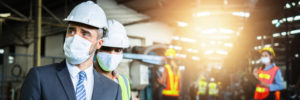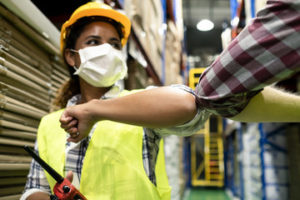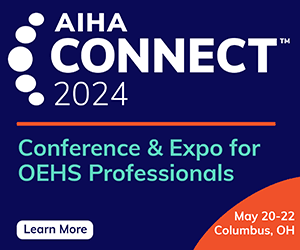The Way Ahead: The Future of Industrial Hygiene, Part 2
Barbara Nessinger, Editor-in-Chief

Technological advancements are reshaping the way health and safety is performed on a daily basis, helping to improve professionals’ capacity to support business growth, while limiting risk to employees. (photo courtesy Adobe Stock)
Industrial Hygiene in the Workplace reached out to numerous companies for expert opinions on a range of subjects that affect how industrial hygiene and safety will change going forward and, most importantly, the issues and challenges ahead. The evolution of industrial hygiene includes improving the ability to anticipate, recognize, evaluate, control and confirm worker protection—across all of the industries that serve this growing field.
Despite setbacks this year by the global pandemic, there is great enthusiasm in the industry, as a whole. This is part 2 of the series; in it, we focus on the diversity of the modern workforce and how 21st Century technology has changed (and improved) the safety game.
From the Silent Generation to Gen-Z
There is no doubt: The workforce of the future will be its most diverse—not just culturally and ethnically—but in the span of ages and experience levels. For the first time ever, safety professionals must protect a workforce that includes five generations: the Silent generation (born between 1928-1945); Baby Boomers; Generation X; Millennials; and Generation Z or the Post-Millennial Generation.
We asked folks how industries that help support industrial hygiene and worker safety can address the needs of this diversely-aged group of workers. Since each of these generations will have had different work experience interacting with health and safety professionals, “it will be difficult for a ‘one size fits all’ approach with these workers,” said the staff at ACGIH. “The industries that support industrial hygiene and safety will need to provide risk communication to the different generations in a manner to which they can respond.” For example, Baby Boomers will likely respond better to a face-to-face meeting on the hazards and controls. The Post-Millennial (Gen Z) generation may prefer short, to-the-point, online training that utilizes animation and music. “Each generation will require risk communication that resonates with their own experience and the preferred method of communication.”

Safety professionals must understand the needs and concerns of all employees by embracing a communicative and collaborative environment. (photo courtesy Adobe Stock)
The ACGIH Board talked about effective communication—how it is a challenge when seeking to deliver standardized messaging across generations. One way to overcome this challenge is through collaboration with professionals that specialize in communication and, specifically, who understand the unique generational needs and know the most effective ways to communicate. Such inter- and intraorganizational partnerships are not typical; however, they possibly could help OHS/EHS professionals to “improve the communication of relevant information and, ultimately, the prevention of occupational illness, disease and injury,” they concluded.
The implementation of “visibly felt leadership” is of utmost importance. “Visible, felt leaders care about people across all generations; they champion the commitment to prevention of occupational illness, disease and injury: and they provide appropriate support and genuine messaging supporting related requirements,” said the Board members.
The folks at both Cority and Blackline safety echoed many of the above sentiments, but also took a very tech-savvy approach to the question. At Cority, for example, the focus was not just on the differences these age groups have, but also on their commonalities. “Vendors need to recognize these differences and offer solutions that are adaptable to meet the needs of these groups, and ideally, fostering opportunities for individuals across generations to engage and work together to resolve some of the most pressing H&S challenges.”
Blackline Safety noted that an increasing number of worksites are undergoing digital transformation and are therefore utilizing devices and leveraging the data they produce to improve safety and productivity. “Naturally,” said Blackline, “these instruments draw various concerns from craftspeople of several generations. Some may share skepticism over their privacy and how the data is being used. Others may have minimal experience with technology and would benefit from being educated on the advantages that digital tools bring to both the organization and each individual worker.” Such education might include how technology enables worksites to approach and address problems from a different, more effective lens.
Safety professionals must understand the needs and concerns of all of its employees by embracing a communicative and collaborative environment, “[b]ecause the only way you can address their needs or concerns, while simultaneously ensuring a safe workplace, is by knowing what they are and embracing an open-door policy,” Blackline concluded.
21st Century Tools
The evolution of industrial hygiene has to include improving professionals’ ability to anticipate, recognize, evaluate, control and confirm worker protection. Use of technology by industrial hygiene/OHS professionals is, therefore, growing exponentially. We asked how our respondents think 21st Century technology can serve as tools to drive innovative preventive measures. Again, the answers were thoughtful and insightful.
“Many of today’s industrial technologies produce millions of data points across a worksite,” opined Blackline Safety. As more organizations adopt technology to drive their safety programs forward, it will be critical for them to track, combine and analyze those data points in an efficient and digestible way. “This will enable safety professionals to better manage risk on their worksites—by understanding threats from multiple angles, such as environmental and operational conditions, allowing them to identify patterns of risk and prevent them from happening again.”
The folks at Cority concurred, also adding that there has been “a rapid acceleration in EH&S technology adoption in recent years, with much of that adoption focused on solutions to enable enhanced real-time risk management at both the worker and asset level.” By enabling organizations to better harness EH&S data to uncover trends or emerging threats in their operations—whether dealing with an unsafe behavior or potential equipment failure—it is thought that businesses will be better equipped to target the precursors of these issues, before they can result in harm to people or business interruption.
Yet, Cority warned, that approach isn’t without challenges. “Data is growing at a rate we’ve never seen before, and that means better risk management isn’t simply a question of collecting more (and better quality) data. It’s also a question of how businesses can more efficiently tease through their collected metadata to uncover those meaningful, actionable insights needed to better inform decisions on where to prioritize efforts, and what specific actions should be taken to reduce risk exposure.”
Opportunities Abound: The Way of the Future

The workforce of the future will be its most diverse—not just culturally and ethnically—but in the span of ages and experience levels. For the first time, safety professionals must protect a workforce that includes five generations. (photo courtesy Adobe Stock)
The growing interest in IoT-enabled devices also provides businesses with opportunities to create a more comprehensive view of organizational risk, through both real-time assets and worker health management.
For assets, businesses can expand the use of remote monitoring devices and sensors to improve asset lifecycle management and failure prediction, thus helping to reduce downtime events and repairs that could place workers at risk. Smart monitors and wearable devices are being adopted at higher frequency, improving real-time monitoring of worker risk exposure and health—even alerting workers of concerning exposures and offering recommendations on steps to take to limit that exposure. And this is all delivered to workers right in the field through mobile devices.
“Those solutions,” said Cority, “when integrated within a larger EHS software platform, can also help businesses trigger additional workflows instantaneously, improving response times to investigate the event and work on mitigation measures.” For example, while a worker is being alerted of their exposure to high noise levels, an investigation can be triggered to help understand the circumstances giving rise to the hazardous work conditions.
By coupling enhanced, real-time data collection practices with more powerful analytics technology, organizations are shifting away from a “diagnose and treat” method to a more predictive approach to risk management. By feeding collected data through analytics tools driven by machine-learning algorithms, firms can use their data to create predictive models that tell them what risks will mostly likely emerge in their operations, and where, thereby enabling business leaders to focus resources on efforts most likely to reduce the potential for harm.
“Advanced solutions may even provide prescriptive insights—recommendations not only about what may happen, but what specifically should be done now to prevent that occurrence—helping reduce decision time and leading to more effective and consistent interventions that lower the risk of loss,” Cority noted. And, since AI-enabled analytics solutions are constantly learning, models are constantly being refined and their accuracy improved—leading to greater confidence in the actions taken to address risk.
Such a melding of technological advancements is reshaping the way health and safety is performed on a daily basis. This improves professionals’ capacity to support business growth, while limiting risk to individuals in the workplace. In other words, a win-win. IHW
[Editor’s note: Part 3 of this series will focus on how the COVID-19 pandemic has changed the industry—and helped to shape its future. Stay tuned!]
ABOUT THE CONTRIBUTORS
We’d like to thank the following people for their assistance and participation in this article’s content. The time these individuals took to give complete, thoughtful answers is greatly appreciated.
-
ACGIH: members of both the ACGIH staff and the ACGIH Board participated
-
Mark Ames, Director of Government Relations, AIHA
-
Dave Angelico, President, Air Systems International, Inc.
-
Sean Baldry, CRSP, Product Marketing Manager at Cority
-
Sean Stinson, Chief Revenue Officer, Blackline Safety
Share on Socials!
Sensor Technology for Peace of Mind
A Matter of Accuracy: Calibrating & Using Personal Sampling Pumps
Air Quality: Mineral Earth Technology
Leaders in Industrial Hygiene
Council for Accreditation in Occupational Hearing Conservation (CAOHC)
Subscribe!
Sign up to receive our industry publications for FREE!







